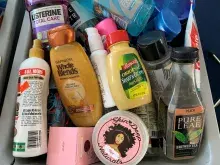
CHARLOTTESVILLE, Va. – The Transportation Security Administration (TSA) has seen travel volume increase this spring compared to last year and the agency is prepared to handle the increased volume.
Individuals who have not flown since before the pandemic or during the early days of the pandemic may be a little “rusty” in terms of remembering all of the checkpoint protocols. Knowing what to expect when you get to the security checkpoint is key to a smooth trip through the checkpoint.
Nationwide TSA officers are screening between 2 to 2.3 million people daily, which is a large increase from last year, but still down significantly from 2019, when closer to 2.5 million people were screened daily during the spring and summer. At Charlottesville-Albemarle Airport, TSA is currently screening about 70 percent of the volume screened pre-pandemic, however checkpoint volume continues to pick up.
“Travelers who are headed out on a vacation typically are not as familiar with security checkpoint
protocols, especially when it comes to knowing what is permitted to be carried through a security checkpoint,” said Robin “Chuck” Burke, TSA’s Federal Security Director for the airport. “We strongly recommend that travelers arrive at the terminal well before their scheduled flight. Here at Charlottesville, I recommend that travelers arrive 90 minutes in advance of their scheduled flights. It’s also important to come prepared for security screening. That means knowing what should and should not be packed in a carry-on bag or checked bag. That’s why we stress that you need to ‘know before you go.’ The TSA web site has a lot of helpful information on preparing for a flight.”
TSA offers several ways for travelers to find out if an item is permitted in a carry-on bag, checked bag, either or neither. The TSA web site has a feature on the homepage called “What can I bring?” Type in the name of the item and it will let you know if it should be packed in a checked bag or carry-on bag. The same handy feature is available on the free downloadable MyTSA app. The MyTSA app gives users 24/7 access to the most frequently requested airport security information on any mobile device, including a searchable database that will let you know whether an item can be packed in a carry-on bag, checked bag, either or neither. The app also identifies delay information and current weather conditions at your favorite airports nationwide.
TSA is also active on social media. Travelers can send a question via Twitter to @AskTSA or via Facebook Messenger for live assistance in answering your questions from 8 a.m. to 7 p.m. ET weekdays; 9 a.m. to 7 p.m. on weekends and holidays.
The most common item that travelers bring to the checkpoint that is not permitted through the screening process are liquids, gels and aerosols that are larger than the acceptable limit. Each passenger may carry liquids, gels and aerosols that are 3.4 ounces (100 ml) or smaller through a checkpoint as long as those items fit into a one quart-sized, resealable bag. This is known as the 3-1-1 bag. Common travel items that must comply with the liquids rule include toothpaste, shampoo, conditioner, sun block, mouthwash and lotions. Containers of liquids, gels and aerosols that are larger than 3.4 ounces (100 ml), regardless of the size container can be transported in checked baggage.
The exception to the 3-1-1 rule is that due to the pandemic, TSA is now allowing travelers to bring one liquid hand sanitizer container up to 12 ounces per passenger in carry-on bags until further notice. Passengers can expect that these containers larger than the standard allowance of 3.4 ounces of liquids permitted through a checkpoint will need to be screened separately, which will add some time to their checkpoint experience.
To reduce touchpoints, it is recommended that travelers place items from their pockets such as wallets, keys, lip balm, tissues and cell phones into their carry-on bags to be screened instead of putting items from their pockets directly into bins. This minimizes the placing of personal items in a bin that you might hold to your face such as lip balm, tissues and cell phones. It also reduces the chance that travelers will leave something behind in a bin.
Individuals who are planning to travel this spring or summer should consider enrolling in TSA PreCheck®. The popular expedited screening program allows travelers to leave on their shoes, jackets, belts and enables them to keep their electronics and 3-1-1 bags in their carry-on bags.
TSA PreCheck membership is more valuable now than ever before because it reduces touchpoints during the pandemic and puts travelers in security lines that have fewer travelers and move quicker, which encourages social distancing.
###

